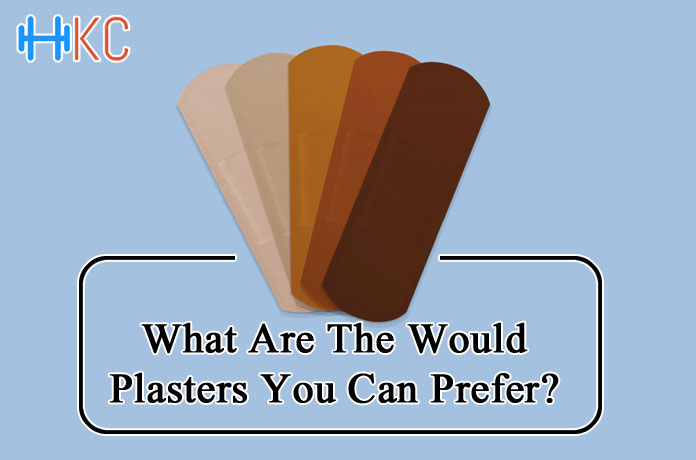What types of plasters are there and what are they suitable for? There are basically six different types of patches with different designs. The plasters can be used not only on the hand, but also just as well on the foot, trunk, or other parts of the body. In the following, we would like to bring you closer to the different types of associations.
Below you will find an idea of the 6 different types:
- Finger plaster
- Adhesive plaster
- Fingertip plasters
- Finger joint plaster
- Plaster strips
- Waterproof plasters
#1. Finger Bandage (Finger Plaster)
A finger bandage has extra-long adhesive surfaces to completely encircle the finger. It is offered as standard in the sizes 2 cm x 12 cm and 2 cm x 18 cm. To the finger bandages in the first aid shop.
As mentioned, a finger bandage is a material that is self-adhesive in nature which is primarily used as a wound pad. These days, finger bandages are made of materials that make them lighter, flexible, and more comfortable to use. As far as the application of finger bandages are concerned, they are quite simple. They can be easily unpacked and apply quickly on the wounded area of the finger. Even if the fingers are sweaty, the adhesive would make sure that the bandage is stuck to the finger. There are multiple different types of these finger bandages that are available these days. Today, you can find water-resistant bandages, HACCP compatible. There are also bandages available that are meant to be used in the kitchen and while performing different types of craftworks. These bandages are free from latex and hence are quite friendly to your skin. There would be no leftover residues on the skin after the bandage is removed.
#2. Classic Wound Dressing (Plaster)
The conventional plaster is ideal for all injuries that occur on a flat surface. These plasters are available in various sizes, ready-made, but also as roll plasters and strip goods to cut yourself off. What makes plasters so special is the fact that they have proven to be very useful when it comes to speeding up the healing process. They are capable of healing a wound two times faster as opposed to different types of other healing methods that are used. They are also very useful for treating different types of wounds. To get the best of results, plaster should be worn for a considerable period of time. These days, there are plasters available that come with water-resistant features and can protect and cover wounds from different types of external and foreign influences. The plasters are made of high-quality polyurethane, which is a skin-friendly material. It is non-sticky and can be removed quite easily after having worn it for a long time. Modern plasters are capable of absorbing the fluid from the wounds and keeps the wound moist. It helps to accelerate the process of healing and thus reduces the chances of scarring to a great extent. These plasters come with a very strong adhesive, which allows them to stick for a long span of time.
Standard dimensions are:
- Finished to size: width 1.9 cm / 2.5 cm and length 7.2 cm
- Rolls and strips: width 2.5 cm / 4 cm / 6 cm / 8 cm and length 5 m adhesive plaster
#3. Fingertip Bandage (Fingertip Plaster)
Injuries to the fingertip or the end of the toe are best bandaged with a tip bandage. The plaster completely covers the tip of the finger or toe. The detectable plasters with their blue color and the integrated aluminum strip are easy to find again even if they are lost and are therefore particularly suitable for the food industry.
There are multiple different types of benefits these plasters have in store for you. They are as follows:
- These plasters can be applied quite easily to the targeted areas, without causing much pain.
- These days, special types, called liquid bandages are available which can be applied without using anesthesia.
- The fact that these plasters keep the wound sealed, the chances of infection are very less.
- These days, water-proof fingertip plasters are available in the market, which can stick for a long period of time, without getting damaged.
- The chances of scarring with these plasters are very less.
#4. Finger Joint Bandage (Finger Joint Plaster)
Wounds in moving areas that are exposed to higher stress are best treated with a joint plaster. The 4 fixation points (adhesive points) around the wound pad also ensure a firm hold at these points. The Detectable plasters are particularly suitable for the food industry, as they are easy to find thanks to their blue color and the integrated aluminum strip.
The use of fiberglass has become very popular these days, as they offer multiple different types of benefits. These materials weigh much lesser, and hence the cast that is made from them is much lighter. They are more porous and durable and last for a long period of time. The fact that they are made of fiberglass, allows easy in and put the flow of air. In case of a compound fracture, fiberglass is a much better option.
#5. Plaster Strips
Like the finger bandage, the plaster strips are cut ready for use and can be stuck over the affected wound immediately. In comparison, the strips are wider, but not as long.
The two standard sizes 1.9 cm x 7.2 cm and 2.5 cm x 7.2 cm can also be found in DIN fillings for first-aid kits and cases.
#6. Waterproof Plasters
These plasters are characterized by their waterproofness. They are very self-adhesive and prevent the wound from coming into contact with liquids, so you can even go swimming with them!
You can also get most of the previously explained types of plaster in the water-resistant variant:
- Plaster strips in a square (3.9 cm x 3.9 cm) or rectangular (2.5 cm x 7.2 cm) shape
- The hand set with finger bandages (2.5 cm x 8.5 cm and 2.5 cm x 6.5 cm) and fingertip bandages (4.4 cm x 5 cm).
The Right Choice
There are different types of wound plaster available today. In drugstores, selected supermarkets, and pharmacies, elastic plasters are offered in various forms. So they can be glued perfectly to fingers, toes, and many other places.
Also, blisters are in some ways to the wound dressings. With their special hydrocolloid or gel padding, they prevent small wounds and blisters on the feet from becoming infected and help small injuries heal more quickly.
When it comes to bandages and plasters, these days, there are multiple different types of them that are available. For healing fractures and other kinds of injuries, they have proven to be quite useful. The use of bandages and plasters for healing different kinds of wounds and injuries goes back many centuries. With time, more advanced versions of these items have evolved, which offer more protection and at the same time ensure that the recovery process becomes fast. If you sustain any major injury, the first thing you need to do is to apply a bandage or a plaster.














